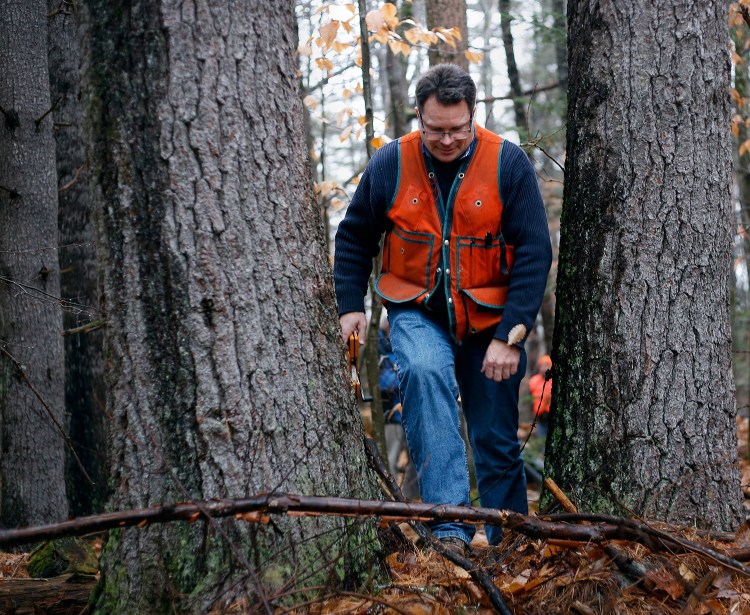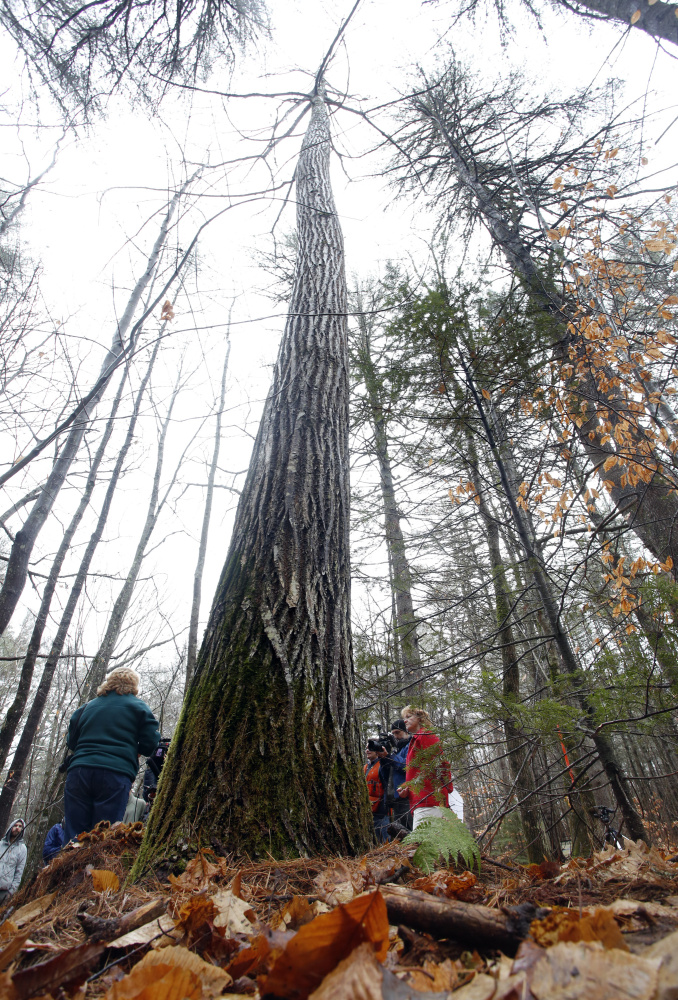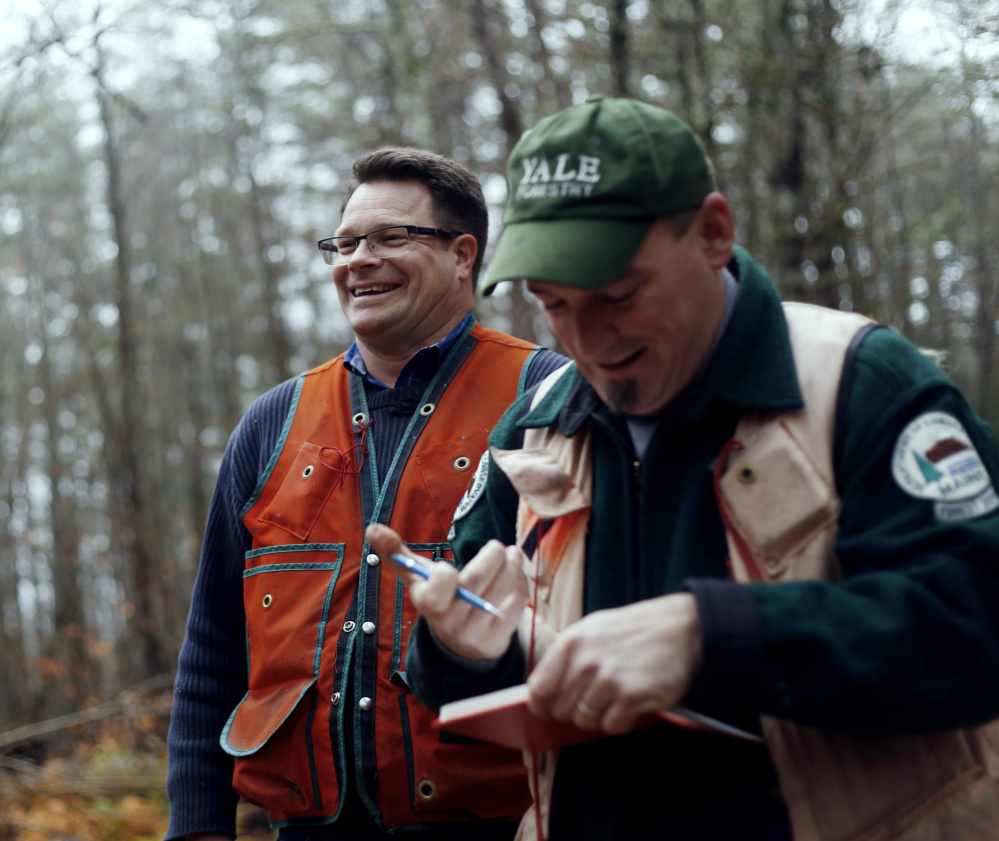LOVELL — The tree, tucked into the vast, pastoral woods of western Maine, is unremarkable to the casual observer and virtually indistinguishable from the hundreds around it, especially in early December when trees are naked.
But a few months ago, when University of Maine forest scientist Brian Roth was flying over the area in a small plane with one of his graduate students, the two spotted it immediately.
Reaching high off the tree’s branches were blossoms of white – the only white mass in a sea of green. It looked almost like snow from that height. It was an American chestnut.
Roth, several other scientists, forestry officials and members of the American Chestnut Foundation returned Wednesday to that site, just off Route 5 in the Oxford County town of Lovell, to take measurements and make official what was suspected this summer.
At 115 feet, it’s the tallest American chestnut tree in North America, and is second only to the tallest known specimen in the world, a 121-footer in an arboretum in Belgium.
“If this keeps growing, it will surpass that,” Roth said Wednesday near the base of the narrow tree.
The find is significant for a number of reasons. American chestnuts, which once accounted for a quarter of all trees on the East Coast, were virtually wiped out in the early to mid-20th century by a parasite accidentally brought to the United States from Asia.
Scientists estimate that there were 4 billion American chestnut trees in 1900.
Now, Roth figures there are only about 200 left in Maine – and 50 of those have been transplanted in an effort to restore the species.
‘REDWOOD OF THE EAST’
Jared Westbrook, a geneticist with the American Chestnut Foundation, said the Lovell find will be helpful in determining what types of soil and other surroundings allowed it to survive when so many others died off.
The foundation was established in 1983 by scientists who wanted to save the noble tree, which once flourished from Maine to Florida and as far west as Ohio. Arborists often refer to the American chestnut as the “Redwood of the East.”
Chestnut trees were immortalized in American literary history by Henry Wadsworth Longfellow, whose 1840 poem, “The Village Blacksmith,” opened with the line: “Under a spreading chestnut-tree/The village smithy stands …” One of Longfellow’s most popular works, the poem refers to a massive chestnut that once grew near the home of a blacksmith who was Longfellow’s neighbor on Brattle Street in Cambridge, Massachusetts, according to the Cambridge Historical Society.
“When the tree was cut down due to safety concerns, children of Cambridge raised money to have a chair constructed from its wood and presented it to Longfellow on his 72nd birthday,” the society says on its website. The chair is now in the Longfellow House National Historic Site on Brattle Street.
Over the last three decades, the North Carolina-based chestnut foundation has created chapters in 16 states, including Maine, and maintains a research farm in Virginia.
A NEEDLE IN A HAYSTACK
In addition to cataloging and finding trees that survived the blight, the foundation has been breeding American chestnut trees with Asian chestnuts to create a parasite-resistant species that could one day thrive on its own.
The tree, which sheds its leaves each year and is a cousin to the beech, once had significant commercial value. Its wood is sturdy and straight, and was often used to build homes and furniture. The chestnuts are a bountiful source of food for wildlife and even humans, sometimes roasted over an open fire.
Lisa Thomson, president of the chestnut foundation, was among those who made the trip to Maine on Wednesday for the measuring. She hasn’t been with the foundation long, but spent nearly three decades at the Nature Conservancy.
Thomson said finds like the one Roth made are invaluable to the foundation’s mission.
The tall tree, as it turns out, is located on land that was bequeathed to the University of Maine Foundation by the family of Douglas Volk, a famous American portrait and landscape painter.
When in full bloom, the American chestnut is majestic – its leaves splayed out to reveal a bulbous bouquet of white blossoms. In fall, the long narrow leaves with their trademark “teeth” tumble to the ground. So, too, do the spiky burs that hold the chestnuts.
Roth said finding the trees are like finding a needle in a haystack.
But he also said there are likely more out there in Maine, a state that is 90 percent forest, just waiting to be found.
Copy the Story Link
Send questions/comments to the editors.






Success. Please wait for the page to reload. If the page does not reload within 5 seconds, please refresh the page.
Enter your email and password to access comments.
Hi, to comment on stories you must . This profile is in addition to your subscription and website login.
Already have a commenting profile? .
Invalid username/password.
Please check your email to confirm and complete your registration.
Only subscribers are eligible to post comments. Please subscribe or login first for digital access. Here’s why.
Use the form below to reset your password. When you've submitted your account email, we will send an email with a reset code.